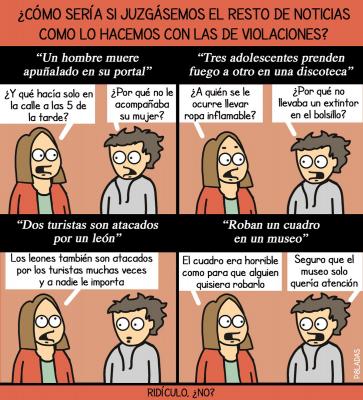What were you wearing? (Tracey Ullman's show) // Tea Consent

Exercise about "What were you wearing?"(Fill in the gaps) HERE.
Seeing as we grow up in a world where people are far more inclined to warn young women not to put themselves in positions that might lead to assault than they are to tell young men not to commit the assaults in the first place, it is unsurprising that, despite the light that has been shed on it, the dialogue surrounding the handling of rape and sexual assault still has the unfortunate tendency to victim blame. And nothing quite sheds the light on how genuinely absurd it is like this BBC sketch about a man getting robbed, which serves as a fitting foil to the questions women are typically (and problematically) asked in the wake of reporting their own assaults.
The sketch, aired on Tracey Ullman’s Show, depicts a man in a police station, reporting his mugging to an officer played by Ullman herself. Visibly shaken, he starts to describe his account, when Ullman interrupts him: "And were you wearing what you’re wearing right now?" Rather than listening to his account, she goes on to tell him that the "provocative wealth" of his attire might have been "inviting" it. A bit later, when a counselor comes into the room, she asks if he was drinking. Together, both women conclude that he will have to take some of the responsibility for the mugging, particularly because he failed to scream or state that he didn’t enjoy the mugging as it was taking place.
Yes, it sounds ridiculous — because it is. But it’s also the reality that far too many women who report their sexual assaults face.
This isn’t the first time that sexual assault crimes have been compared to robberies to highlight the problematic way that they are handled. RAINN gathered the statistics, and found that out of 1000 rapes, only 310 are reported; out of 1000 robberies, 619 are reported. (Considering that victims are faced with questions like the ones highlighted in the sketch, and that the vast majority of assaults are committed by someone the victim knows, this disparity — while unsettling — is not very surprising.) Out of those 1000 incidents, 67 of the rapes will lead to an arrest and only six to an incarceration, whereas 167 of the robberies will lead to an arrest, and 22 to incarceration.
What these statistics highlight are the true root of the problem: society’s tendency to disbelieve and dismiss women. Approximately 90 percent of sexual assault incidents involve female victims, which is why the language surrounding sexual assault is often so problematically gendered, victim-blaming, and irrelevant to the actual crime at hand — all of which discourages victims from coming forward in the first place. According to RAINN, approximately two out of three incidents of sexual violence go unreported; of those who gave reasons for not reporting the crime, 13 percent said they "believed the police would not do anything to help," and two percent said they "believed the police could not do anything to help."
Given the unfortunate nature of these statistics, it is all the more important that platforms like this both give a platform to and help contextualize the problem to make people more aware of it — and hopefully, encourage people to support victims of sexual violence and treat incidents in the same manner other crimes are handled, rather than question them in the manner the sketch is parodying.
By Emma Lord
Exercise (Correct the mistakes) about "Tea Consent" HERE.
Finally: Can you translate the cartoon into English?
0 comentarios